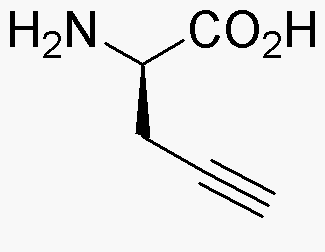D-Propargylglycine is widely utilized in research focused on:
- Neuropharmacology: This compound acts as an inhibitor of the enzyme cystathionine γ-lyase, which is involved in the production of hydrogen sulfide, a signaling molecule in the brain. Its application helps in studying neurodegenerative diseases and potential therapies.
- Metabolic Studies: Researchers use D-Propargylglycine to investigate metabolic pathways involving sulfur-containing amino acids. This aids in understanding metabolic disorders and developing nutritional interventions.
- Cardiovascular Research: The compound's role in modulating hydrogen sulfide levels makes it valuable for studying cardiovascular health, particularly in conditions like hypertension and heart failure.
- Pharmaceutical Development: D-Propargylglycine serves as a lead compound in the synthesis of new drugs targeting various diseases, providing a scaffold for the development of novel therapeutic agents.
- Biochemical Assays: It is commonly used in laboratory assays to measure enzyme activity related to sulfur metabolism, offering insights into various biochemical processes and disease mechanisms.
General Information
Properties
Safety and Regulations
Applications
D-Propargylglycine is widely utilized in research focused on:
- Neuropharmacology: This compound acts as an inhibitor of the enzyme cystathionine γ-lyase, which is involved in the production of hydrogen sulfide, a signaling molecule in the brain. Its application helps in studying neurodegenerative diseases and potential therapies.
- Metabolic Studies: Researchers use D-Propargylglycine to investigate metabolic pathways involving sulfur-containing amino acids. This aids in understanding metabolic disorders and developing nutritional interventions.
- Cardiovascular Research: The compound's role in modulating hydrogen sulfide levels makes it valuable for studying cardiovascular health, particularly in conditions like hypertension and heart failure.
- Pharmaceutical Development: D-Propargylglycine serves as a lead compound in the synthesis of new drugs targeting various diseases, providing a scaffold for the development of novel therapeutic agents.
- Biochemical Assays: It is commonly used in laboratory assays to measure enzyme activity related to sulfur metabolism, offering insights into various biochemical processes and disease mechanisms.
Documents
Safety Data Sheets (SDS)
The SDS provides comprehensive safety information on handling, storage, and disposal of the product.
Product Specification (PS)
The PS provides a comprehensive breakdown of the product’s properties, including chemical composition, physical state, purity, and storage requirements. It also details acceptable quality ranges and the product's intended applications.
Certificates of Analysis (COA)
Search for Certificates of Analysis (COA) by entering the products Lot Number. Lot and Batch Numbers can be found on a product’s label following the words ‘Lot’ or ‘Batch’.
*Catalog Number
*Lot Number
Certificates Of Origin (COO)
This COO confirms the country where the product was manufactured, and also details the materials and components used in it and whether it is derived from natural, synthetic, or other specific sources. This certificate may be required for customs, trade, and regulatory compliance.
*Catalog Number
*Lot Number
Safety Data Sheets (SDS)
The SDS provides comprehensive safety information on handling, storage, and disposal of the product.
DownloadProduct Specification (PS)
The PS provides a comprehensive breakdown of the product’s properties, including chemical composition, physical state, purity, and storage requirements. It also details acceptable quality ranges and the product's intended applications.
DownloadCertificates of Analysis (COA)
Search for Certificates of Analysis (COA) by entering the products Lot Number. Lot and Batch Numbers can be found on a product’s label following the words ‘Lot’ or ‘Batch’.
*Catalog Number
*Lot Number
Certificates Of Origin (COO)
This COO confirms the country where the product was manufactured, and also details the materials and components used in it and whether it is derived from natural, synthetic, or other specific sources. This certificate may be required for customs, trade, and regulatory compliance.


